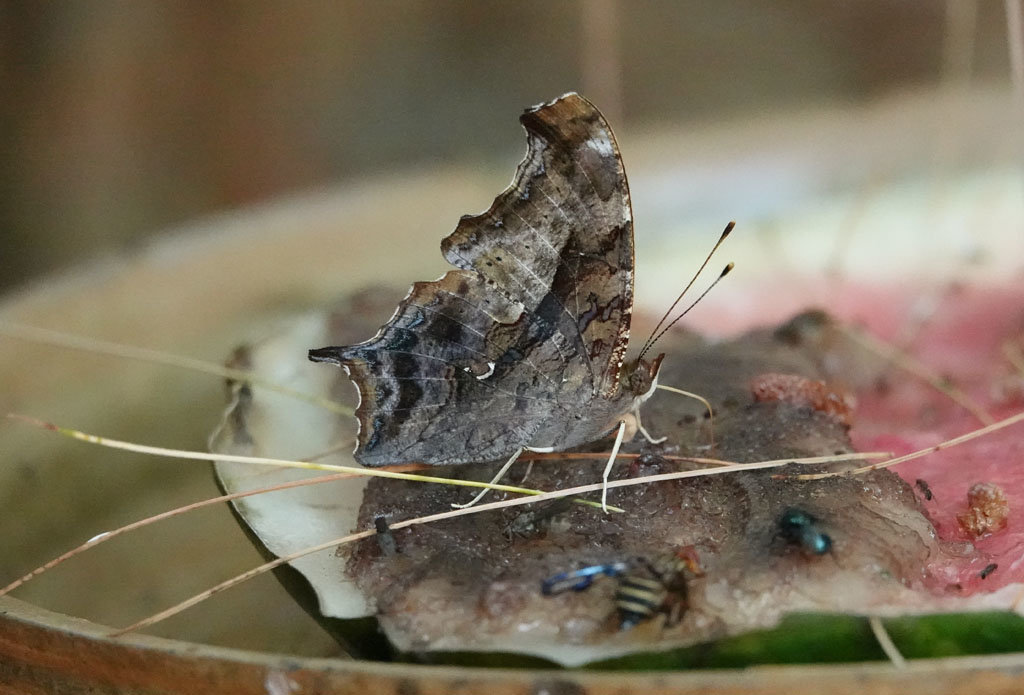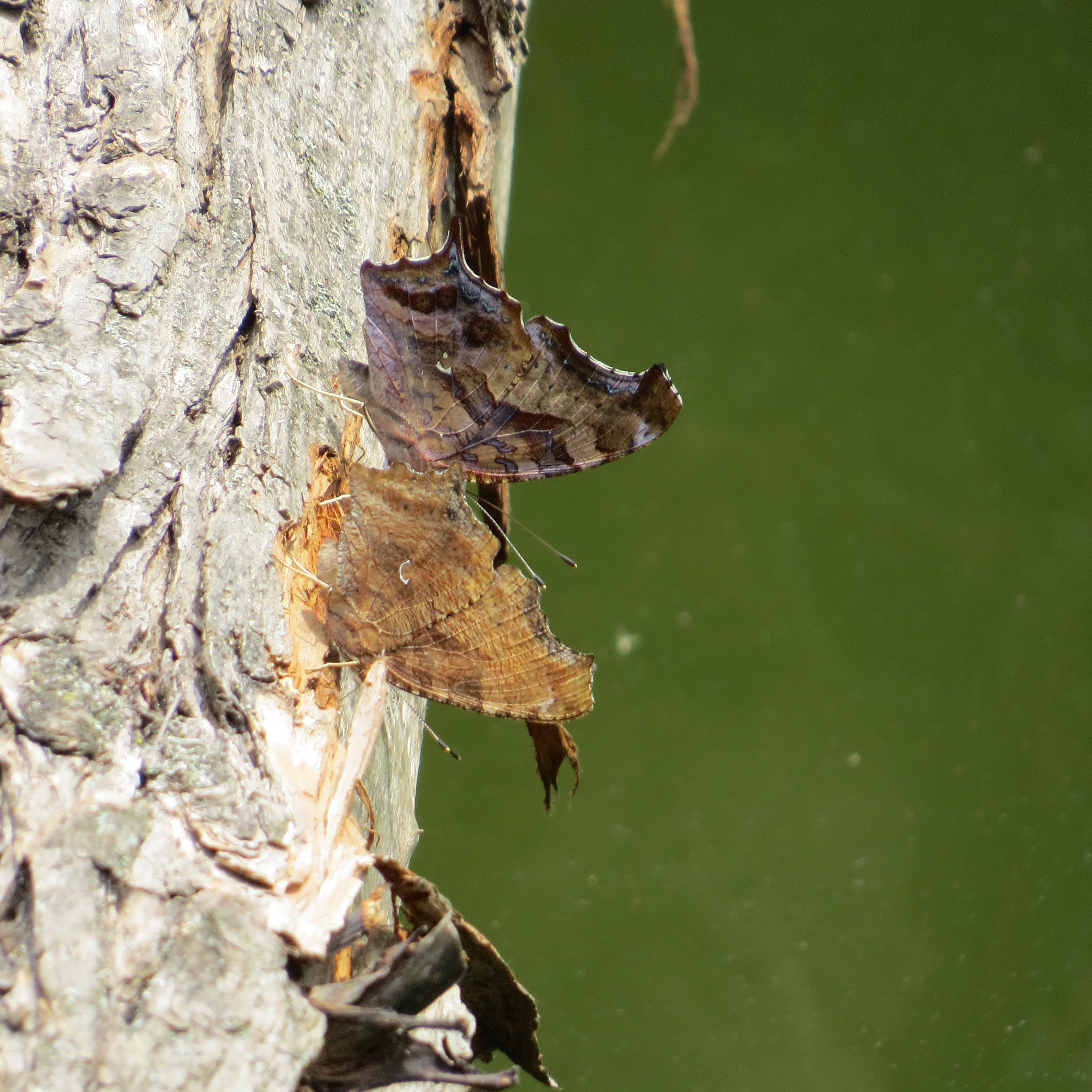
Our two local anglewings, the eastern comma and the question mark, show many similarities besides their physical resemblance:
- They share a mostly-overlapping range with each other, south from Maine to Florida and west to the Dakotas, and are the most widespread and southernmost members of the genus Polygonia in eastern North America. (The four other Polygonia of the East – gray comma, hoary comma, satyr comma, and green comma – are generally limited to northern woodlands).
- Their caterpillars feed on a similar mix of host plants, including elms and nettles.
- Both species occur here in two, clearly-distinct broods – one brood in early summer and, weeks later, a second in late summer/early fall.
- Many individuals of both species of that second brood over-winter as adults in South Jersey (unlike all but two or three others of our 90+ species), and both species regularly fly in late-winter and early-spring, usually weeks ahead of all but the mourning cloak, their fellow Nymphalid.
- As adults, both species feed frequently on sap, dung, and rotten fruit, and neither one nectars regularly on flowers.

- Both species also migrate southward in fall and some individuals, at least, seem to migrate north in spring. The question mark has occasionally erupted northward from southern states in huge migratory flights, most recently in May 2012.
- Both their populations also ebb and flow obviously from year to year – numerous and hard-to-miss some years, tougher-to-find in other years.
And that leads to our ecology puzzle: Are their two populations also in sync with each other? In other words, do their many similarities lead to similar records of ups and downs, so that they share the same good years and bad years? Or, do they differ in their ecologies so much that one can boom while the other busts, and vice-versa?
I called upon my junior-high spreadsheet skills to see how our log’s numbers might answer those questions.
A Note About Numbers:
The Reeves’ system that powers our log enables us to measure and compare abundance and yearly fluctuations in two different ways – by total reports for a species in a given year or by total individuals counted in all reports of that species for the year. Each method has its pluses and minuses, but in this case the question mark irruption of 2012 distorts our individuals’ totals significantly. Observers estimated a total of 5000+ individuals on the peak day of the flight, May 4. That was more question marks reported in one day than we have ever recorded for the species in any other full year. To avoid that distortion problem and to keep things simple, I am using total records as the comparison measures for the three graphs below.
The question mark has long been considered the more numerous of the two species in our area. Arthur Shapiro made this point in his Butterflies of the Delaware Valley in 1966, and Gochfeld & Burger came to the same conclusion in their Butterflies Of New Jersey in 1997 (citing sources going back to the late 1800s). Our log records confirm that the question mark continues to be more common. Over our log’s first ten full years, 2009-2018, we compiled an average of about 220 reports/year and 845 individuals totaled/year for the question mark. The comma’s numbers were lower on both counts: 124 reports/year and 295 individuals totaled/year.
Two Trend Lines:
The trend lines in the first two graphs below of all reports suggest that the comma seems to be increasing in South Jersey while the question mark seems to be declining. I am uncertain whether these trends are meaningful. Both trends are modest, and they might be temporary – part of a longer cycle, where a species increases or decreases for five or ten years and then returns to its former numbers.
Booms & Busts:
But what about those booms and busts? Are commas and question marks so similar that they share good years and bad years in parallel?
To make comparisons easier, the bars in the next graph indicate each species’ numbers vs. its own 10-year average (calculated for 2009-2018) as the standard. The 100 line = 100% of that 10-year average.
“Good” & “Bad” Years
Each species has had five “good” (= above average) years and eight “bad” (below average). The question mark’s five have been 2010, 2011, 2012 (its best year by far), 2017, and 2019. The comma’s above-average years have been 2014, 2016, 2017, 2018, and 2019, a string of five good years in six and followed by 2020 with a count right at 100% of the 10-year average.
In Sync?
One hint that their similar ecologies lead them to struggle at the same time are the three years when both had numbers well below their averages – 2009, 2015, and last year, 2021. They also have shared two or three “good” years – 2017 and 2019, and 2011, when the comma reached its average while the question mark totaled 120% of its average.
Or Not?
The story grows more complicated when we look at the five years of 2010, 2012, 2014, 2016, and 2018, when one species boomed while the other busted. The years 2012 and 2014 seem the clearest examples of mismatched booms and busts: in the question mark’s best year of 2012 the comma had its second-worst (of our log’s thirteen); in the question mark’s second-worst year in 2014, the comma had numbers well above its average.
One key to these mismatches might be differences in their host plants. Most texts list elms, nettles, and hops for both anglewings, but their specific preferences seem to differ. Our log has many reports of question mark using hackberry as a host, for example, but I don’t see that as a listed host for eastern comma, and I can’t seem to remember log reports or photos of comma using hackberry. If you have photos or remember them doing so, can you please send me a note?
Another possible difference involves stinging nettle (Urtica diocia). That plant is often listed as a host for eastern commas but not, it seems, for question marks. Anyone with a photo or a memory of a question mark ovipositing on stinging nettle or their caterpillars using it?
Butterfly gardeners, please let us know which plants the anglewings have used in your yard. You may know more about the host plants for these two species in South Jersey than anyone!
Your Thoughts?
I will stop here and invite comments from anyone with other thoughts about these numbers. I see several complications we could explore, along with questions about host plants:
Is thirteen years of logging too short a period to draw lines of population trends? Does that question mark boom year of 2012 distort its record for all our log’s thirteen years so far? As many of us have become better butterflyers over the years, with more experience and better field guides, do we now separate more commas from question marks than we used to? (If so, that could create an apparent rise of the first and decline of the second.) Are the ecologies of the two species actually so different – despite their many apparent similarities – that comparing them is like comparing apples and oranges and so finding parallels or contrasts is self-delusion? And so on.
I am also reminded of a line I saw recently in Doug Tallamy’s The Nature Of Oaks: “Ecology is not rocket science,” a friend once observed, “It’s much more complicated than that!”
Our blog’s comments tool had to be disabled as it was plagued by spam. Thoughts, questions, or complaints can be emailed to me nacotejackATgmailDOTcom and I will post below. Thanks for reading!
jc

[PS: The anglewing in Jeanine Apgar’s photo at the top of this post is an eastern comma.]
